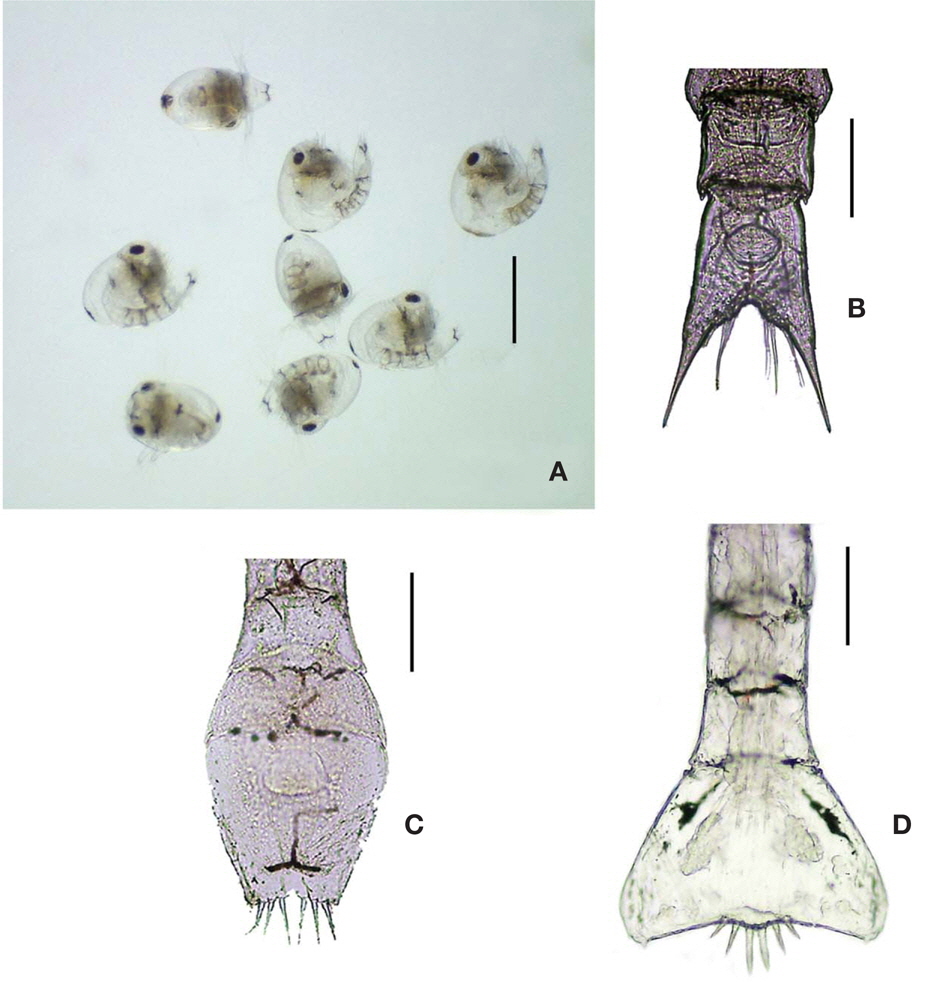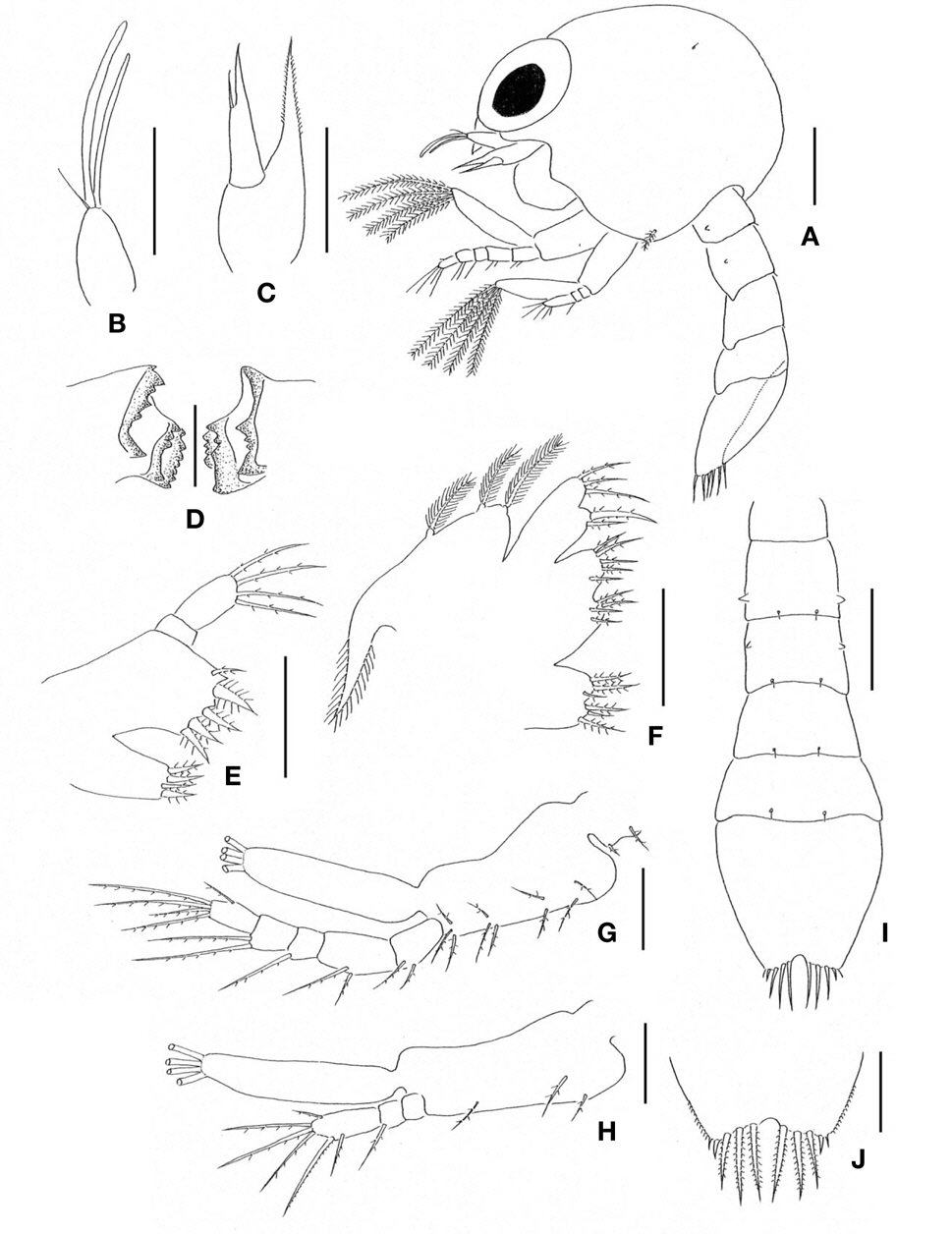Crabs of the Camptandriidae currently include 37 species of 19 genera in the world (Ng et al., 2008), of which, three species of three genera have been reported in Korea (Kim, 1973; Kim and Kim, 1997): Cleistostoma dilatatum (De Haan, 1833), Deiratonotus cristatum (De Man, 1895), and Camptandrium sexdentatum Stimpson, 1858. They inhabit mudflats between high and low tidal marks. The type genus Camptandrium contains only one species, C. sexdentatum and has a wide Indo-West Pacific distribution from India, Thailand, Indonesia, China, Japan, to Korea (Tan and Ng, 1999). Larvae of C. dilatatum and D. cristatum have been described by Kim and Lee (1982) and Terada (1979); however, those of C. sexdentatum are unknown.
In the present study, the first zoeal stage of C. sexdentatum is described and illustrated for the first time. Its characteristics are compared with those of other two species of the family.
On 2 June 2012, an ovigerous crab of C. sexdentatum was collected at the muddy sand flat in Namhaedo Island, Gyeongsangnam- do, Korea (34˚49′44.55′′N, 128˚02′12.28′′E). Its zoeas hatched in the laboratory on 6 June 2012 and were preserved in 95% ethanol for examination. Zoeal specimens were dissected using a Leitz zoom stereomicroscope and appendages were examined under a Leitz Laborlux S microscope (Leica, Wetzlar, Germany). Drawings were made with the aid of camera lucida. Setal counts and measurements were based on ten specimens. The sequence of the zoeal description is based on the malacostracan somite plan and described from anterior to posterior. Setal armature of appendages was described from proximal to distal segments and in order of endopod to exopod (Clark et al., 1998). The long plumose natatory setae of the first and second maxillipeds were drawn truncated. A micrometer was used for zoeal measurements: carapace length (CL) was measured from the anterior margin of the eyes to the most posterior carapace margin. The brachyuran classification follows that of Ng et al. (2008). The remaining zoeas and the spent female were deposited at Silla University, Korea.
Order Decapoda Latreille, 1803Family Camptandriidae Stimpson, 1858Genus Camptandrium Stimpson, 1858
Camptandrium sexdentatum Stimpson, 1858First zoea(Figs. 1A, 2A-J)
[Fig. 2.] Camptandrium sexdentatum, first zoeal stage. A, Lateral view; B, Antennule; C, Antenna; D, Mandibles; E, Maxillule; F, Maxilla; G, First maxilliped; H, Second maxilliped; I, Dorsal view of abdomen and telson; J, Posterior region of telson. Scale bars: A, I=0.1 mm, B-H, J=0.05 mm.
Size: CL 0.35±0.01 mm.
Carapace (Figs. 1A, 2A): Rostral spine extremely short, dorsal and lateral spines absent; 1 pair of posterodorsal setae present; each ventral margin with 1 plumose seta; eyes sessile.
Antennule (Fig. 2B): Uniramous; with 2 long aesthetascs and 1 small seta distally.
Antenna (Fig. 2C): Protopod spinulate distally, longer than rostral carapace spine; exopod approximately equal length to protopod, simple distally, with 1 submedial seta.
Mandibles (Fig. 2D): Asymmetrical.
Maxillule (Fig. 2E): Coxal endite with 4 setae; basial endite with 5 setae (4 plumodenticulate); endopod 2-segmented, proximal segment without seta, distal segment with 4 setae.
Maxilla (Fig. 2F): Coxal endite bilobed, with 3+3 setae; basial endite bilobed, with 4+5 setae; endopod bilobed, with 2+3 setae; scaphognathite with 3 marginal plumose setae and 1 distal stout process.
First maxilliped (Fig. 2G): Coxa with 2 setae; basis with 10 setae arranged 2+2+3+3; endopod 5-segmented, with 2, 2, 1, 2, 5 (1 subterminal+4 terminal) setae; exopod with 4 long plumose natatory setae distally.
Second maxilliped (Fig. 2H): Coxa without seta; basis with 3 setae arranged 1+1+1; endopod 3-segmented, with 0, 1, 6 (3 subterminal+3 terminal) setae; exopod as in first maxilliped.
Abdomen (Figs. 1A, C, 2A, I): With 5 somites, significantly broadened posteriorly; somites 2, 3 each with 1 pair of lateral processes; somites 2-5 each with 1 pair of posterodorsal setae; pleopod buds absent.
Telson (Figs. 1A, C, 2I, J): Subovoidal, narrowing posteriorly; fork absent; posterior margin with shallow median cleft and 5+5 processes, which increasing its length towards inside.
Color (Fig. 1A, C): Black chromatophores on posterodorsal region of carapace, around mouthparts, on base of each maxilliped, on each abdominal somite, and on posterior region of telson.
Based on zoeal descriptions of two species, Cleistostoma dilatatum by Kim and Lee (1982) and Deiratonotus cristatum by Terada (1979), Ko and Lee (2012) reported that the zoeas of Camptandriidae could be distinguished from other Korean brachyurans by having the following characteristics: 1) endopods of the maxillule and maxilla each with 0, 4 and 2+3 setae, respectively, 2) basis of the first and second maxillipeds each with 2+2+3+3, 1+1+1 setae, respectively, and 3) short rostral and dorsal carapace spines. In the present study, the zoea of C. sexdentatum agrees with their description, except dorsal carapace spine. In respect to other characteristics, such as no lateral carapace spines and a telson without forks, it is significantly different from those of the other two species having lateral carapace spines and telson forks (Table 1).
A subquadrate telson with forks (Fig. 1B), as seen in zoeas of C. dilatatum and D. cristatum, is usually found in brachyuran zoeas. A subovoid telson without forks (Fig. 1C) in C. sexdentatum is reported for the first time, although, a triangular telson without forks (Fig. 1D) is reported in a pinnotherid, Arcotheres sinensis (Shen, 1932) by Ko (1991) and a leucosiid, Philyra pisum De Haan, 1841 by Ko (1996).
Long larval spines which increase the surface area are considered to be morphological adaptations to enhance buoyancy (Calado, 2009). So, zoeas of the above three species (C. sexdentatum, A. sinensis, and P. pisum) without dorsal and lateral carapace spines might be difficult to stay stationary in turbulent sea water. Therefore, it is considered that zoea of C. sexdentatum should be equipped with an abdomen broadened posteriorly and a subovoidal telson for the purpose of buoyancy and swimming.










